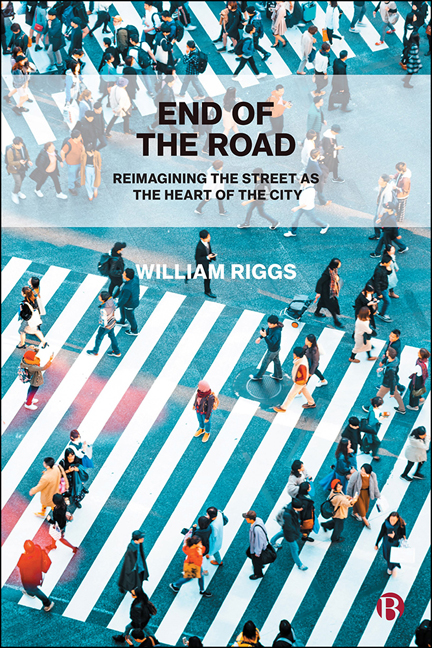Book contents
- Frontmatter
- Dedication
- Contents
- List of Figures and Tables
- Acknowledgments
- 1 Introduction
- 2 A Recent History of the Street
- 3 The Street for Transport
- 4 The Street as Economic Space
- 5 The Street as Social Space
- 6 The Street as Cultural Space
- 7 The Street as a Natural Space
- 8 Challenges to Ending the Road
- 9 Beyond Streets: Integrating Behavior
- 10 A Window into the Future: New Vehicles, New Streets
- 11 A Call to Action: Streets as the Heart of the City
- Appendix
- Notes
- References
- Index
4 - The Street as Economic Space
Published online by Cambridge University Press: 12 October 2022
- Frontmatter
- Dedication
- Contents
- List of Figures and Tables
- Acknowledgments
- 1 Introduction
- 2 A Recent History of the Street
- 3 The Street for Transport
- 4 The Street as Economic Space
- 5 The Street as Social Space
- 6 The Street as Cultural Space
- 7 The Street as a Natural Space
- 8 Challenges to Ending the Road
- 9 Beyond Streets: Integrating Behavior
- 10 A Window into the Future: New Vehicles, New Streets
- 11 A Call to Action: Streets as the Heart of the City
- Appendix
- Notes
- References
- Index
Summary
Consider two human patterns. On the one hand, consider the fact that certain Greek village streets have a band of whitewash, four or five feet wide, outside every house, so that people can pull their chairs out into the street, into a realm which is half theirs, half street, and so contribute to the life around them.
And on the other hand, consider the fact that cafes in Los Angeles are indoors, away from the sidewalk, in order to prevent food from being contaminated. Both these patterns have a purpose. One has the purpose of allowing people to contribute to the street life and to be part of it—to the extent they desire—by marking a domain which makes it possible. The other has the purpose of keeping people healthy, by making sure that they will not eat food that has dust particles on it. Yet one is alive; the other dead. (Alexander, 1979, p 119)
As quoted by Christopher Alexander, one street can be alive and one can be dead. But what is it that makes a street thrive? Just like in the streets of New York, San Luis Obispo or Anaheim, the thing that makes streets work is that they are transactional. They are where exchange happens. And in my mind this exchange comes in many forms: shopping, food and people talking. They are all transactions and trade— things that are the core economic elements of why cities ever formed. Hence, in this chapter, we focus on the things that make the street an economic space.
We can likely all cite an example of what we think of as a “dead” street versus one that is economically vibrant. Whether from an experience walking down a road that is vacant and lonely, to the visions in post-apocalyptic films such as I Am Legend, Mad Max, The Day After Tomorrow, Wall-E (you get the picture), we intrinsically know what makes a street alive. (And I’ll note that there are a number of films with visions of great streets that are not apocalyptic, favorites being Spike Lee’s Do the Right Thing and Woody Allen’s Midnight in Paris.)
For me, the vibrant streets in Louisville and Chicago provide great examples of how planners and policy makers can harness the power of the street.
- Type
- Chapter
- Information
- End of the RoadReimagining the Street as the Heart of the City, pp. 48 - 60Publisher: Bristol University PressPrint publication year: 2022



